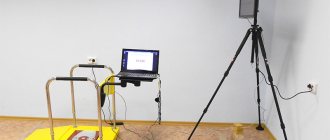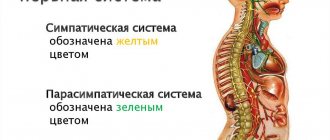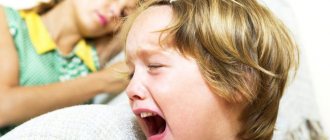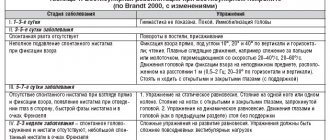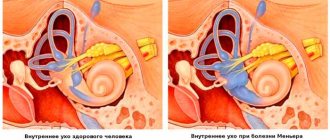Dizziness and vestibular disorders are related. The human vestibular apparatus is located in the inner part of the hearing organ. The human vestibular apparatus has receptors that are very sensitive and immediately detect any changes in body position. Vestibular vertigo creates a sensation of imaginary rotation of objects around the patient. Most often it is caused by certain damage to the vestibular apparatus; dizziness occurs as a result of damage to the central or peripheral parts of the vestibular analyzer. Other types of dizziness are associated with various diseases and are not related to damage to the vestibular system.
At the Yusupov Hospital they diagnose diseases that cause vestibular vertigo. In the hospital you can undergo examination, treatment and recovery in a rehabilitation clinic. The clinic carries out rehabilitation measures, uses therapeutic exercises, and various types of physiotherapeutic procedures. Instructors select exercises on simulators for patients suffering from dizziness. The vestibular apparatus, which is treated using various methods, is restored in 50-80% of patients after treatment and rehabilitation.
How to treat vestibular vertigo
Dizziness is a common complaint among patients about feeling unwell. Women and the elderly most often suffer from dizziness. Depending on the cause of dizziness, the doctor prescribes treatment. Treating dizziness is a difficult task for a doctor. He refers the patient for examination to determine whether dizziness is caused by diseases. The patient is prescribed symptomatic treatment, which helps to remove symptoms - nausea, vomiting, and stop attacks of dizziness. Vestibular suppressors are used to stop attacks. To prevent attacks from developing, your doctor may prescribe anticholinergic drugs. Such drugs are prescribed with caution to elderly people due to side effects - hallucinations, amnesia, they can cause urinary retention and psychosis in an elderly patient. Some types of antihistamines and benzodiazepines are also prescribed to enhance the inhibitory response of GABA to the patient’s vestibular system.
Vestibular vertigo: symptoms and treatment in older people
Dizziness (vertigo) is manifested by the illusion of rapid rotation of objects around the patient. It may be accompanied by vomiting, nystagmus, nausea, and ringing in the ears. When vestibular vertigo develops in older people, the causes can be varied: lack of blood supply to the brain (cerebral ischemia), multiple sclerosis, head injuries, some types of brain tumors, tumors of the auditory nerve, hormonal imbalance, atherosclerosis, and other disorders. Treatment of vestibular vertigo (vertigo) in older people begins with finding the cause of the dizziness and treating the underlying disease. Vestibular gymnastics for dizziness in older people improves well-being, has a beneficial effect on the heart, musculoskeletal system, and nervous system. Treatment of vestibular vertigo is carried out with the help of drug therapy, physiotherapy, physical therapy, and reflexology.
Possible reasons for the violation
One of the reasons may be basilar syndrome. This pathology can be congenital or acquired. The symptoms of the disease are explained by serious disruptions in brain function. At the initial stage of development of the deviation, the patient will feel an imbalance along with pain in the back of the head. The pressure level also changes. Along with these symptoms, the patient experiences numbness in the arms and legs, along with severe weakness and serious visual impairment. In the later stages of the disease, even speech may be impaired in patients.
It is important to begin treatment for vestibular disorders in a timely manner.
The cause of the disease is also the development of thrombosis of the auditory artery. Patients suffer from severe dizziness, and at the same time noise in the head. Hearing decreases and partial deafness may occur. Thrombosis occurs when the sound arteries are blocked. Sometimes emergency intervention is required, as there is a risk of hemorrhage.
Meniere's syndrome is another cause of disorders. It is a very rare disease. Symptoms are expressed by attacks of dizziness, and, in addition, the appearance of ringing in the ears or in one ear. Dizziness initially reaches a maximum, and then declines. Loss of coordination may also persist.
Vestibular neuronitis is an acute viral lesion preceded by ischemia and otitis media. This deviation may be associated with cranial and brain injuries. The main symptom is frequent dizziness and loss of coordination. Symptoms appear up to two weeks.
The development of bilateral chronic vestibulopathy also causes disturbances in the normal functioning of the vestibular apparatus. May occur during antibiotic therapy. The disease, as a rule, develops slowly, initially manifesting itself with dizziness, and then decreased hearing. The patient may experience jumping blurry images while moving the head. Symptoms are closely related to general intoxication of the human body.
Diseases of the vestibular system and dizziness
There are a number of diseases that lead to disorders of the vestibular apparatus:
- Vertebrobasilar syndrome.
- Meniere's syndrome.
- Vestibular neuronitis.
- Thrombosis of the auditory artery.
- Chronic bilateral vestibulopathy.
Vestibular vertigo can be caused by damage to the vestibular nucleus of the brain stem, the vestibular centers of the brain and vestibular connections may be affected. If the vestibular analyzer is affected, the patient will experience certain symptoms:
- Noise in ears.
- Hearing loss.
- Constant dizziness.
When the central parts of the vestibular apparatus (cerebellum, brain stem) are affected, benign paroxysmal positional vertigo, vestibular neuronitis or Meniere's disease are most often diagnosed.
What is the vestibular apparatus?
The correct functioning of the organ in question is extremely important to ensure normal human life. Loss of balance and poor orientation while performing any tasks are often caused by disruption of the apparatus. The symptoms are as follows: a person is unable to walk in a straight line, perform precise movements; in particularly serious cases, it is difficult for him to even get up from the couch or have lunch without help. He may suffer from vomiting, and at the same time from nausea, fainting, pressure surges, excessive sweating, problems with the eyes and pulse rate.
The vestibular apparatus in humans is located within the inner ear. It consists of endolymph, and, in addition, of its constituent jelly-like elements and otoliths, as well as ciliated cells. But the main center is located directly in the brain of the head: it is there that all the information about the position of the body, the force of pressure in the organ, information from the visual organs and receptors that are located in the limbs are collected. Failure in the operation of at least one of the links provokes disorders of the vestibular apparatus. The pathology can manifest itself immediately in the form of nausea and dizziness.
The symptoms and treatment of vestibular disorders are interrelated.
Benign vestibular vertigo
Benign vestibular vertigo is most often considered a pathology of the inner ear; dizziness often occurs when turning the head to the side. The disease may manifest as sudden severe dizziness, nausea and vomiting. Paroxysmal benign positional vertigo develops as a result of the deposition of calcium salts in the ampulla of the semicircular canal. Peripheral vestibular vertigo occurs when the peripheral part of the vestibular apparatus is damaged. Systemic vestibular vertigo is manifested by symptoms of swaying one's own body, rotating objects, bending or falling, accompanied by impaired hearing, balance, nausea and vomiting. Caused by damage to the central or peripheral part of the vestibular system.
Exercises for vestibular vertigo
Dizziness often occurs when turning the head or body - this forces patients to try to avoid such movements. Gymnastics for patients with vestibular system disorders includes various types of exercises, including exercises with head and body turns. Exercises can be performed while sitting on a bed, with or without a pillow, sitting on a chair, or standing. The exercises are based on the principle of sensory mismatch between the movements of the eyes, torso and head. Special simulators that work on the principle of biofeedback will help increase the effectiveness of gymnastics. During the training period, you should avoid taking sedatives and alcohol.
Symptoms of the disease
A diseased vestibular apparatus in humans manifests itself with the following symptoms:
- The occurrence of dizziness and nystagmus, when frequent rhythmic movements of the eyeballs appear. This is the most obvious indicator.
- Poor balance, lack of coordination, swaying.
- Nausea, which is sometimes accompanied by vomiting in patients.
- Profuse sweating.
- Rapid breathing and heart rate.
All such manifestations can occur periodically, and usually occur suddenly. Most patients notice them against the background of changing weather conditions, unexpected noise, large crowds of people, while traveling by bus. Otherwise, patients do not experience any problems with their well-being.
What is the treatment for vestibular disorders?
Tablets for vestibular vertigo
Drugs for vestibular vertigo are Betaserc, Betagistin, Tagista, Vestibo, as well as drugs that support the endocrine system, the heart, and reduce blood pressure. Betaserc improves blood circulation in the brain and promotes the functioning of the vestibular apparatus. Betahistine is often used in complex treatment; it helps with nausea and vomiting. Tagista improves blood circulation in the brain and reduces lymph pressure in the labyrinth of the inner ear. A stable effect is achieved after a month of treatment. Vestibo improves blood circulation in the inner ear and brain; the drug is used in complex therapy.
Prevention
In order to prevent the occurrence of all kinds of disorders of the vestibular apparatus, as well as to minimize their manifestation, it is recommended to reconsider your diet (you need, for example, to introduce the consumption of fruits and vegetables), it is advisable to walk outside more and more often, regularly ventilate the room and actively play sports.
Thus, many are familiar with the concept of “vestibular apparatus”. But not everyone knows exactly where it is located and what its main functions are. This organ is an integral part of the inner ear and a special sensitive receptor that is responsible for a person’s orientation in space. Considering the importance of this system, it is necessary to promptly eliminate any violations.
We looked at the symptoms and treatment of vestibular disorders.
Treatment in Moscow
The best treatment for vestibular disorders is considered to be exercises for dizziness or vestibular rehabilitation. Vestibular rehabilitation is carried out in many special centers, including the rehabilitation center of the Yusupov Hospital. Therapeutic gymnastics is carried out by an instructor, classes are developed individually for each patient. A preliminary examination by a neurologist will help determine the cause of dizziness, and the doctor will prescribe effective drug treatment. A neurologist will tell you what examination to undergo and how to cure vestibular vertigo during your consultation.
Gymnastics
You can try to cope with this problem with the help of special gymnastic exercises. For example:
- Conducting eye training. You need to move your gaze from top to bottom, and then from left to right. The head is left motionless. Repeat this twenty times, and then gradually speed up the pace.
- Performing bends. They lean forward and backward, and then left and right. They do this ten times with their eyes open, and then the same number, but with their eyes closed.
- Carrying out shoulder exercises. The starting position is done while sitting on a chair. First they shrug their shoulders, and then take turns moving them in different directions.
- Performing a move. They move around the room with their eyes open. Then they repeat the same route, but with closed ones.
In general, treatment of the vestibular system with folk remedies and gymnastics are very popular.
The problem is always solved. The main thing is to consult a doctor on time and follow all doctor’s instructions.
